Pgiam/iStock via Getty Images
We believe in the theory of contrary opinion, and the Sentiment King focuses on studying and measuring investor sentiment and investor expectations. This article is part of a continuing series of articles (here) on how to use investor activity in ETFs to measure investor sentiment and help determine the direction of the stock market. Since ProShares has over 130 ETFs with more than $50 billion in assets – many with 2X and 3X leverage – it is the perfect fund family to use for this purpose.
UDOW – ProShares UltraPro Dow30
UDOW is one of eleven 3x ProShare ETFs (the UltraPro Series) that goes long a major market index, in this case the Dow 30. It has 12.1 million shares outstanding and total assets of $509 million. It’s ranked 23rd by total assets of 136 funds in the ProShare family.
Asset Ranking of ProShare ETFs (Michael McDonald)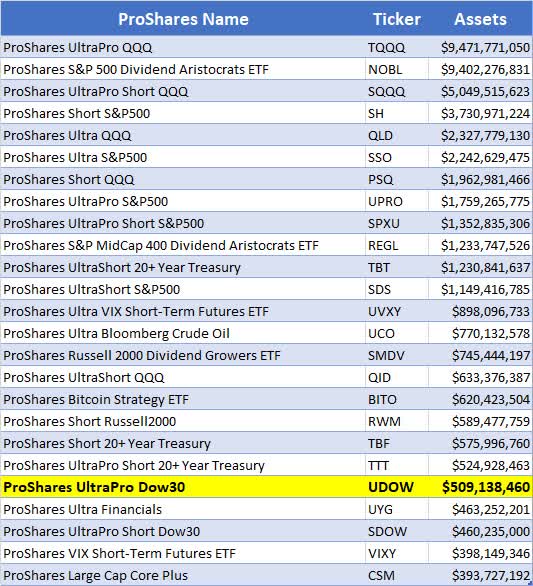
ProShares writes the following about UDOW:
ProShares UltraPro Dow30 seeks a return that is 3x the return of its index (target) for a single day, as measured from one NAV calculation to the next. Due to the compounding of daily returns, holding periods of greater than one day can result in returns that are significantly different than the target return and ProShares’ returns over periods other than one day will likely differ in amount and possibly direction from the target return for the same period. These effects may be more pronounced in funds with larger or inverse multiples and in funds with volatile benchmarks. Investors should monitor their holdings as frequently as daily. Investors should consult the prospectus for further details on the calculation of the returns and the risks associated with investing in this product.
UDOW Graph
This graph shows the entire price history of UDOW since inception in 2010. It started with an adjusted price of $3.33 on February 9th, 2010, and it’s currently at $41.90 as of October 14th. This is a huge gain of 1158% and is due to the 3x leverage, low interest rates and the long-term bull market that began during the financial crisis of 2008.
Graph of UDOW NAV (Michael McDonald)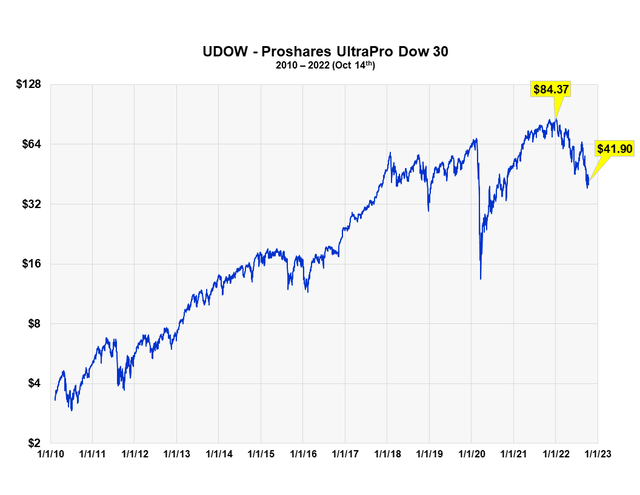
At the beginning of the year, the fund was at $84.37. During the bear market, it has fallen 50.3% to $41.90. However, it should be noted that the current price is quite a bit higher than the lows made during the COVID bear market of 2020. With investor sentiment currently so bearish, from a contrary opinion point of view, this is a positive indicator.
Outstanding Shares of UDOW Aren’t Growing
The graph below plots DIA, which is the ETF that represents the Dow 30, against the number of shares outstanding in UDOW. When more investors enter the fund than leave it, the number of shares outstanding increases. When more investors sell the fund than buy it, the number deceases. Shares outstanding are currently at 12,100,000 shares.
UDOW Shares Outstanding vs DIA (Michael McDonald)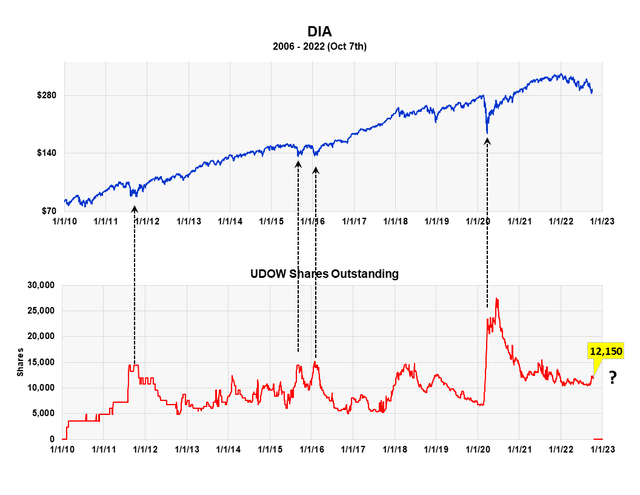
History shows short term traders in UDOW have a good track record. On a relative basis, they own the greatest number of shares at market bottoms and a smaller number at market tops, which is the way it should be. In other words, investor activity in UDOW seems to violate the theory of contrary opinion. I’m not one to argue with this – facts are facts. In the case of UDOW, the theory doesn’t seem to apply.
The black dotted lines point to these moments, and the chart clearly shows that important stock market bottoms seem to occur when shares outstanding are rapidly rising. Three major market bottoms occurred, each accompanied by a surge in shares outstanding. This phenomenon is similar to what we see in the ProShare 3x QQQ fund – TQQQ (here).
But looking at the chart, the number of shares outstanding in UDOW have not increased during this bear market. They have in TQQQ but not UDOW. So, if this is a major market bottom, as many sentiment indicators seem to suggest, this idea is not yet confirmed by growth in the number of shares outstanding of UDOW.
This is a little confusing since it’s counter to what so many other ProShare funds seem to indicate as well as general sentiment indicators – that the market is headed higher. However, if one believes in the historical UDOW data, the obvious conclusion would be that the bear market is not over and probably won’t be over until investors in UDOW begin to buy again, as they have in the past.
Purchasing Levels of UDOW
How do you measure investor buying in ETFs? Looking at daily dollar sales like one does, any stock is insufficient since it doesn’t specify how much is from investor buying. With stocks, sales do represent the amount of buying, since buying and selling amounts are always equal. But with ETFs they aren’t. If there are more buyers than sellers of an ETF, the fund creates more shares for the excess buyers. If there are more sellers than buyers, they retire the excess shares.
So, sales numbers alone don’t tell you how much money is going into or out of an ETF; you must combine sales with changes in the number of shares outstanding to determine that. Once this is done, multiplying the number of shares being purchased by the fund’s NAV yields how much money is going into the fund on a daily basis. We measure average buying activity over twenty trading days
Measuring the dollar amount going into a fund is not the best measure, however. What’s better is the amount of money going into the fund divided by the total assets in the fund. Producing a ratio allows for historical comparisons; absolute values don’t. The current purchasing ratio for UDOW is 30.8%.
Historical purchasing ratio of UDOW vs the DIA (Michael McDonald)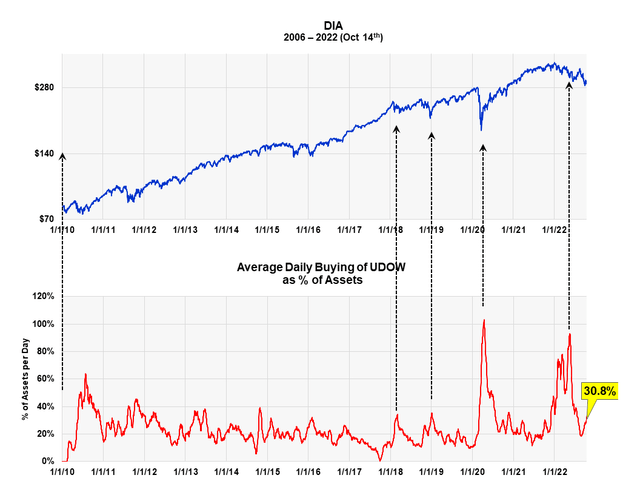
The current ratio is comparable to the ratios at the market lows of 2018 and 2019 but far short of the ratio of 100% made at the bottom of the market in 2020, or 96% registered in May of this year, prior to the bear market rally. This seems to reinforce the idea in the last section that the bear market is not over.
The Ratio of Bull and Bear Assets in ProShares ETFs
The ProShares bull to bear asset ratio is another way we measure investor sentiment or expectations. It’s a contrary opinion indicator. It takes the dollar value in all the ProShares bull funds and divides it by the dollar value of all the bear funds. At the market top in December, there was over 10 times more money in bullish ProShares ETFs than bear market ETFs. It is now down to a little over two.
For example, the graph clearly shows the surge of money into ProShares bull funds from September to December of last year, right before the start of the bear market. The ratio went from 6.5 to 10.5. Extremely bad timing. The current ratio is two to one, which is much closer to the bear market lows of 2020.
ProShare Bull to Bear asset ratio (Michael McDonald)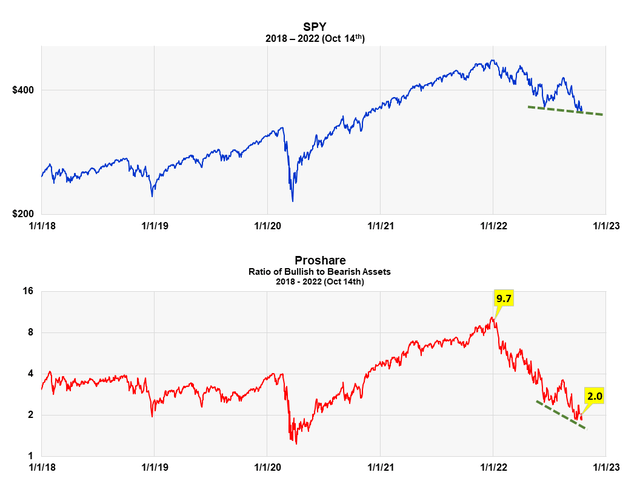
What’s important now is that the asset ratio went to new lows as the S&P just slightly broke below the price lows of May. Notice the two broken green lines in the graph. It’s flat for stocks and slanted lower for the ratio. This means that even more ProShares investors believe the market’s headed lower than at the May low. This again is what you want to see if you’re a contrarian. It suggests stock prices should move higher over the intermediate term. This idea is just not yet confirmed by metrics on investor activity in UDOW.
An Important Caveat
While I’m not so worried about the American economy dragging down the stock market, I am worried about the risk of a global financial crisis doing it, triggered by the actions of narrow-minded central bankers focused on just their own economy. While central banks are looking after their own economies, no agency is looking after the well-being of the entire global financial system. This is a serious issue, which I explain in the second half of the article I just wrote on the Puts and Calls ratio (here).


Be the first to comment